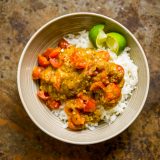In tropical Cartagena, coconuts come in all forms: shredded, clustered and candied to make cocadas; whole, with only the stem chopped off, an oversized vessel for an on-the-go cocktail; even raw, shaved into paper-thin slices for a crisp garnish.
But it’s coconut milk that proves the most adaptable culinary medium. It can carry through a meal like a leitmotif, reappearing again and again. At the shoebox-size El Boliche restaurant, it turns up in a rich, orange-tinged sauce for shrimp ceviche, in a bed of browned coconut rice propping up grilled sea bass and, in the last spoonful of the evening, in a creamy rice pudding-like dessert spiked with raspberry jam.
Coconut milk is a familiar enough ingredient, but in Cartagena, it’s transformative—and not just because it’s used in more creative ways. Even in simple applications like steamed rice and braised chicken, it provides fresh, buttery flavor, a silky texture and floral fragrance. Something about Cartagena’s coconut milk is different.
To learn the secret, I had to travel an hour inland, past palm plantations and a canal that wends its way from the mouth of the Magdalena River to the Atlantic, down a long dirt road to a place where cooks still prepare meals over wood fires.
Maria Caseres uses coconut milk almost daily. It’s a local ingredient, as versatile as broth. She uses it to steam rice, to cook chicken, to make soup.
Today, it will be the base of a coarse bright-yellow sauce laced with allspice berries, bouillon powder and a packet of annatto-heavy sazón. in this region of Colombia, often used for chicken and shrimp. Today Caseres’ father—and my guide—Danilo, has bought some whole fish for lunch.
But the coconut milk for this meal will not come from a can. In this village, and all along the Colombian coast, it’s made from scratch, by means of a process that would daunt even the most industrious of American home cooks.
Caseres can break down three coconuts in half an hour. Equipped with a piece of rebar and a knife, the 21-year-old wallops the husk until it cracks into pieces, draining the coconut water into a bowl. Then she pares the hard, hairy layer away, placing each bright white wedge of coconut meat in the water. Now for the grating.
According to Caseres, this labor-intensive process is the hardest lesson to master in the cuisine of San Basilio de Palenque, an isolated village established in 1603 by Africans who escaped Cartagena’s colonial slave trade. She sits in a plastic chair in her family’s backyard—busy with ducks, chickens and the occasional dog or cat—and grates the coconut meat into a bowl balanced on her lap. She sucks in her upper lip as she grates, shreds accumulating in the bowl like a snow bank.
She gets water from a well, pours several cupfuls over the coconut and mixes. Then she takes a fistful of saturated shreds and squeezes hard, sending coconut milk trickling into the bowl. She sets aside the wrung-out pulp. When she’s gone through the entire heap of shreds, she strains the milk. This is just the first pressing—she’ll repeat the process up to six more times, sometimes grating the pulp anew to draw out fresh oils.
The first batch of milk tastes smooth, but not fatty or creamy. More like 2 percent than whole milk. The second batch’s body is slightly thinner. Both have rich, fresh flavor.
The milk with the fullest body is earmarked for the fish, which Caseres cleans, salts and deep-fries over a fire set below three stones that hold a battered pot in place. While it fries, she feeds coconut husks to the fire and gives the spent shreds to the chickens in the yard.
In side-by-side tastings of homemade and canned coconut milks, we favored the homemade, which was light and smooth compared to canned, which had a thick, viscous body. We wondered if ingredients could account for the difference, but the can listed the same two we’d used—coconut and water. Turns out, it’s the processing method that matters. Canned milk is made by extracting milk from finely ground coconut meat using a screw press—the same type used to separate wood pulp and water for making paper. The extract is recombined with water to produce a milk of uniform consistency and fat, usually between 19 and 21 percent. Our homemade milk uses shredded coconut, which has 30 percent fat, but even with blending and pressing on the solids, only some of the fat emulsifies in the water, producing a milk that’s lighter in body and brighter in flavor.
Homemade Coconut Milk
- 1¾ cups unsweetened shredded coconut
- 2⅓ cups warm water
In a blender, combine the coconut and water. Let stand until the coconut begins to soften, about 1 minute. Blend on high until creamy, 1 to 2 minutes. Pour into a fine mesh strainer set over a large measuring cup or medium bowl, pressing on the solids. Discard the solids. You should have 1¾ cups milk, or about 1 can.
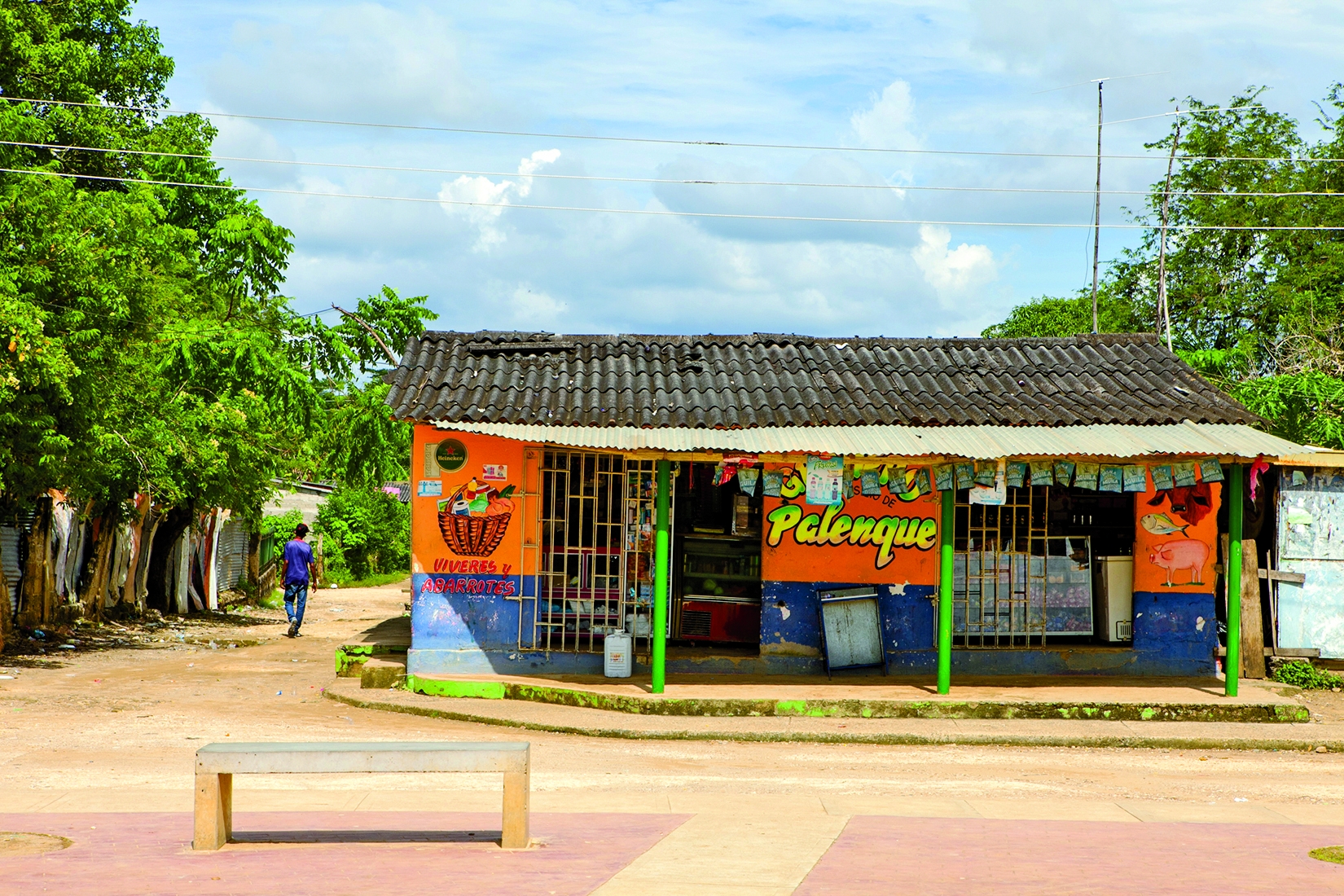
Once the fish is done, she pulls the pot off the fire, discards the oil and adds the seasoning packet, allspice and bouillon powder to the fish. Slices of tomato and onion, mashed garlic and salt go in as well. Finally the coconut milk. She sets the fish aside to meld with its flavorings.
Meanwhile, she makes the rice. The formula is simple: rinsed rice, salt and the second pressing of coconut milk. She covers the pot with a banana leaf, then a lid, and knocks some wood away from the fire to tame the heat. As the rice cooks, the edges of the leaf curl up and singe. When Caseres lifts the covering to check on the rice, a thin layer of coconut oil coats the top. She stirs occasionally so the grains absorb the fat.
As the rice cooks, Caseres finishes the fish on a conventional stove, basting it with the now-yellow sauce. The tomatoes and onions have wilted. She spoons some sauce onto the back of her hand and scrutinizes, then tastes it. Five more minutes.
Lunch is served inside on waxy banana leaves, one whole, sauce-coated fish per leaf, plus fresh onions and tomatoes dressed with vinegar. Caseres brings over the rice and spoons it onto our leaves. The scent—buttery and sweet but subtle—is intoxicating. We eat with spoons made of coconut husks and drink beers bought from one of the stores in Palenque’s main square.
It’s one of the best meals I’ve had in Colombia, and certainly the most memorable. The coconut is perfectly calibrated, lending floral fragrance and silky texture to the fish and the rice, enhancing rather than overpowering the other flavors.
Not until I returned to Milk Street did I fully appreciate the importance of fresh coconut milk in the meal I had had in Palenque.
The dish Caseres made was pescado con leche de coco, one of a family of coconut milk recipes in Colombia, often differing only in protein. To keep our version approachable (but no less authentic), we skipped the whole fish and made pollo (chicken) con leche de coco. That was easy.
We knew, however, that we could not call for coconuts, not to mention rebar. So, for our first attempt, we used canned coconut milk. The results were heavy, bordering on gloppy. We tried diluting the milk with water, with no success. We even switched to coconut water—to dial back the texture—but the dish lost its dimension.
Fortunately, a shortcut to fresh coconut milk proved simple. Combining warm water and unsweetened shredded coconut in a blender, letting the shreds soak briefly, then blending the mixture until creamy produced coconut milk that was bright and smooth—almost identical in taste and texture to what Caseres made.
Armed with the proper liquid for braising, we recreated the flavoring of Caseres’ subtly spiced fish. Allspice, garlic and onions stayed the same, but we opted to use turmeric and soy sauce to more easily replicate the savoriness of the sazón and bouillon. Tomato paste added depth, and fresh cherry tomatoes—stirred in along with fresh lime juice—brightened the chicken.
Best of all, the meal turned out to be an ideal weeknight dish. While the chicken cooked, we made the coconut rice, which steamed in about the same time it took for the coconut milk sauce to reduce. In under 45 minutes, we were eating fresh coconut milk, velvety chicken and rich, buttery rice as good as any in Cartagena.
How It’s Made: Coconut Milk
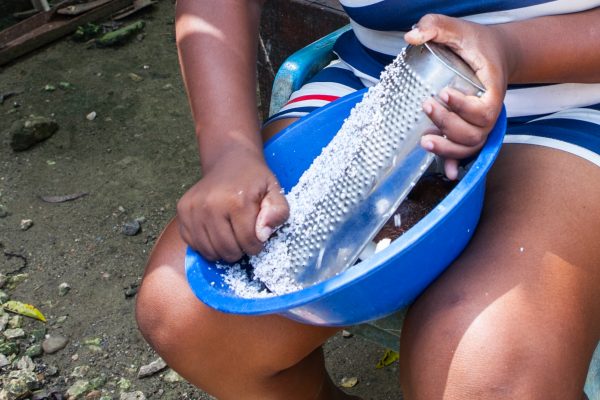
Once cracked, the coconut is finely grated.
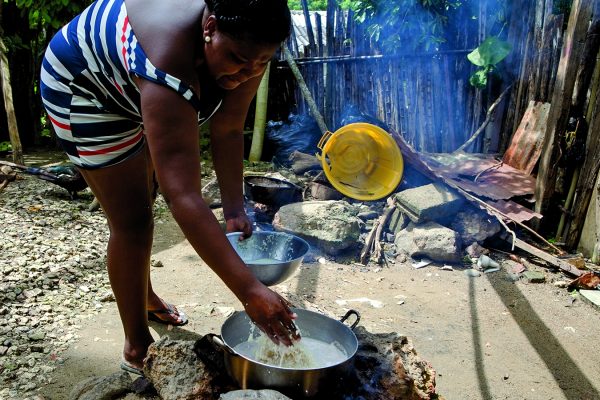
After it’s squeezed and strained, the coconut milk is mixed with rice and salt.
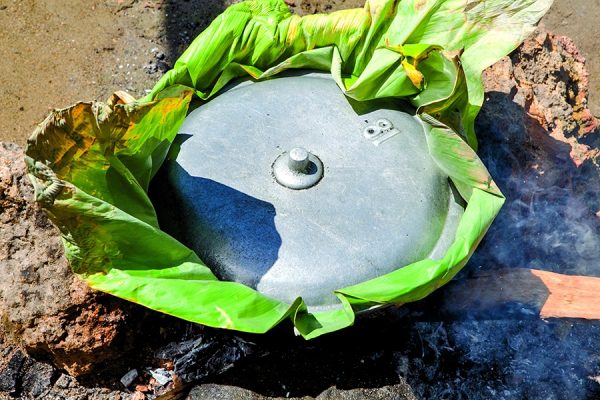
A banana leaf aids the steaming.
Related Recipes
May-June 2018

Sign up to receive texts
Successfully signed up to receive texts!
We'll only send our very best offers - Like a $15 store credit to start.
By entering your phone number and submitting this form, you consent to receive marketing text messages (such as promotion codes and cart reminders) from Christopher Kimball's Milk Street at the number provided, including messages sent by autodialer. Consent is not a condition of any purchase. Message and data rates may apply. Message frequency varies. You can unsubscribe at any time by replying STOP or clicking the unsubscribe link (where available) in one of our messages. View our Privacy Policy and Terms of Service.
